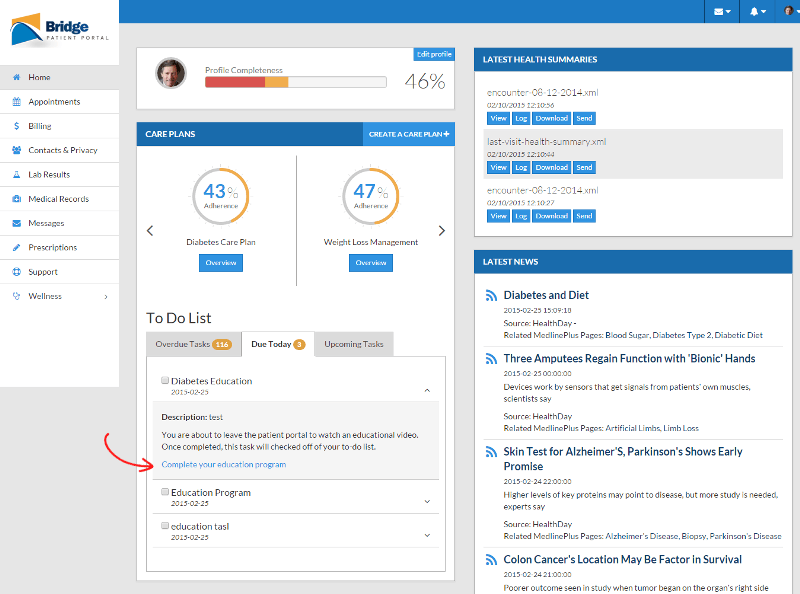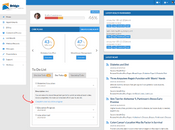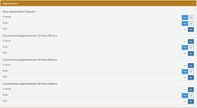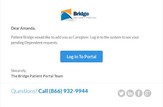Bridge Patient Portal Features Released in 2015
- Blake Rodocker
- June 23, 2015

Thus far, 2015 has been a year of tremendous growth for Bridge Patient Portal. Our team has worked hard to introduce new functionalities in the portal that improve usability, enhance performance and productivity, and establish Bridge as the leading EHR-agnostic patient portal. We have also taken user feedback into account and have developed features that improve the user experience for both providers and staff and patients.
Here’s a look at some of the key features added to Bridge Patient Portal this year:
Personalized Patient Education Solution Make Care Plans More Interactive
In 2015, Bridge partnered with healthcare communications company Emmi Solutions to incorporate personalized patient education solution into the Care Plans portion of the portal. When creating a Care Plan task, providers now have the option of selecting from over 250 patient education resources.
Once the Care Plan task is created, the educational resource is automatically added to the patient’s “To Do List,” which can be accessed from the patient portal home page.
When the patient clicks to complete the education program, he or she is taken to the Emmi Solutions website to watch a video related to his or her condition. After the video has been watched all the way through, the task in the patient portal gets checked off as complete.
New Form Engine Helps Improve Patient Intake
With the creation of a more comprehensive patient intake form, Bridge makes it easy to obtain critical information prior to a patient’s visit. Our new intake form is easy to fill out, and it helps health organizations collect data such as patient demographics, insurance information, patient and family medical history, current medications, and more. Past information is also pre-populated in the form, saving the patient from completing redundant information. Forms are 100 percent customizable, allowing practices to preserve their current form library in Bridge Patient Portal.
New Options for Scheduling – Appointment Types and Forms
In order to improve the scheduling process for clients, we added several new features for administrator users.
- Creating a new type of visit. From the admin side of the portal, users can create new types of visits (e.g. office visit, follow-up appointment, new patient). These visits appear as options for patients to select when submitting an appointment request.
- Attaching patient forms to types of visits. When creating a new type of visit, admins can also attach forms for patients to fill out when an appointment request is approved. For example, a patient submitting a request for a “new patient” visit may be required to fill out a new patient intake form.
- Attaching forms during scheduling. If a visit type does not have a form attached to it, users now have the option of adding one before confirming an appointment request. This is useful for getting information from specific patients only versus all patients submitting requests for a specific visit type.
Patient Appointment Reminder Settings Reduce Cancellations & No-shows
With the addition of advanced patient appointment reminder settings, health organizations now have important tools at their disposal to reduce last-minute appointment cancellations and no-shows – one of the leading sources of revenue loss for medical practices.
The following new features were added, all of which can be configured by the admin user:
- Appointment confirmation notifications. When a doctor schedules an appointment with a patient (versus the patient requesting an appointment themselves), the portal generates an appointment confirmation message. Once the patient confirms the appointment, the status in the patient portal changes to “Scheduled and Confirmed.”
- Patient appointment reminders. For all scheduled appointments, reminders can be sent out to patients 12, 24 and/or 48 hours prior to the scheduled visit time. There are three options for appointment reminder delivery: through a message in the patient portal, by email or via SMS text message.
- Staff notifications for unconfirmed appointments. New portal settings allow users (providers and/or staff) to receive a notification when a patient fails to confirm his or her scheduled appointment. This allows for the necessary follow-up to take place in order to avoid no-shows.
Codes Added for ICD-10
To help our clients prepare for the October 1, 2015 ICD-10 deadline, we incorporated ICD-10 codes into the patient portal. If a SNOMED-CT term applies to an ICD-10 code, the ICD-10 code gets displayed in the portal. This is configurable per installation.
Easy Options for Marketing the Portal to Patients
In the marketing section of the portal, we added filters that make it easy to market the portal to specific groups of users in order to increase engagement. The first step is generating a list of users. This may include:
- Users who registered for the portal but have never logged in.
- Users who have logged in within a date range.
- Users who have not logged in within a date range.
Once the results of the search are displayed, health organizations may choose to either send a message to all users directly from the portal, or download a CSV file with user information in order to market to those patients externally.
Care Plan Updates Help Improve Patient Engagement
The following updates are helping to improve patient engagement with the online portal and increase Care Plan interaction.
- Care Plan messages sent from the doctor. Studies have shown that patients are 90 percent more likely to read an email if it is addressed from their doctor rather than an automated system (e.g. Bridge Patient Portal or Main Street Family Practice). For this reason, we have configured the portal so that all outgoing messages to patients regarding Care Plan tasks are sent with the doctor’s name as the sender.
- Adding videos as Care Plan tasks. Videos can now be added as tasks in the Care Plans To-Do List section of the portal. If a patient needs to watch a video as part of his or her care plan, he or she can do so easily from the portal home screen.
- Assigning forms as Care Plan tasks. Forms can also be assigned as tasks in the Care Plans section of the portal. Assigned tasks will appear on the portal home page in the To-Do list.
Third-Party Device Integration
Bridge is proud to support third-party device integration, making it easy for patients to share information with their physicians without entering data manually into the portal. Data can be exported from the portal to the EHR so that it is readily available to the doctor.
Fitbit is the first device that Bridge Patient Portal supports, but other integrations are coming soon.
Disabling the Portal for Maintenance
We made it easy to disable the patient portal for maintenance by adding a Maintenance configuration for admin users. To access the setting, the admin must log in to the portal, click “Settings” in the left-hand menu, then “Configurations.” From the Configurations screen, the user should select the “Client” option, click “Yes” for maintenance and save changes.
This disables the portal, preventing users from logging in while scheduled updates are being performed.
Adding a Caregiver to an Account
In addition to allowing users to add dependents to their accounts, Bridge also allows users to add caregivers. To access this screen, users can click on “Contacts & Privacy” in the left-hand menu. Once a caregiver is added in the system, the person will receive an email to accept the request.
External Forms Sharing
In order to make it easy for patients to fill out required forms, we implemented external forms sharing. This allows patients to complete forms securely without registering for or logging in to the patient portal. Forms can be shared via a secure link on a health organization’s website, or the link can be sent privately to a specific patient. Once the form is completed, it gets added to the patient’s health record and can be exported to the EHR.
Phone eConsultations
Bridge implemented Twilio this year, a voice communication application that makes it easy to conduct phone eConsultations from the patient portal. The feature can be enabled from the admin section of the patient portal – all health organization needs in order to get started is a Twilio account.
What’s in Store for Bridge in Q3 & Q4 of 2015?
In the second half of 2015, the Bridge Patient Portal team is focusing on enhancing our care coordination modules, developing advanced support for pediatric and long-term care environments and improving the care plan module. Finally, native mobile device support will also be released towards the end of 2015.
Interested in learning more? Call 866-838-9455 to speak with a portal expert today or fill out our contact form online.





